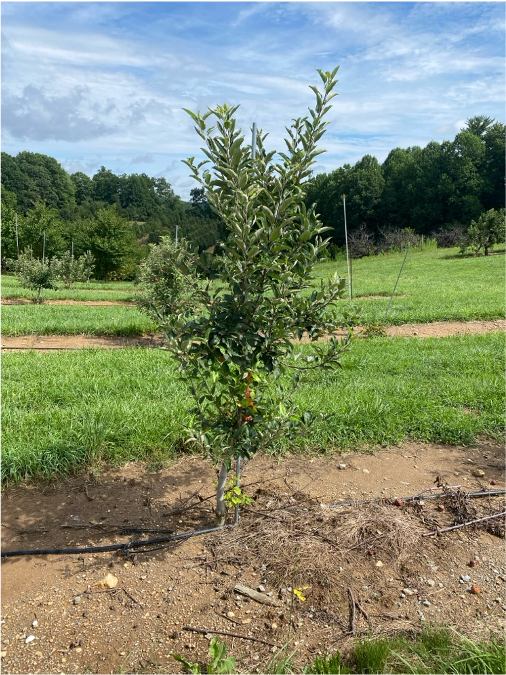Tips for Growing Apple Trees
go.ncsu.edu/readext?1016750
en Español / em Português
El inglés es el idioma de control de esta página. En la medida en que haya algún conflicto entre la traducción al inglés y la traducción, el inglés prevalece.
Al hacer clic en el enlace de traducción se activa un servicio de traducción gratuito para convertir la página al español. Al igual que con cualquier traducción por Internet, la conversión no es sensible al contexto y puede que no traduzca el texto en su significado original. NC State Extension no garantiza la exactitud del texto traducido. Por favor, tenga en cuenta que algunas aplicaciones y/o servicios pueden no funcionar como se espera cuando se traducen.
Português
Inglês é o idioma de controle desta página. Na medida que haja algum conflito entre o texto original em Inglês e a tradução, o Inglês prevalece.
Ao clicar no link de tradução, um serviço gratuito de tradução será ativado para converter a página para o Português. Como em qualquer tradução pela internet, a conversão não é sensivel ao contexto e pode não ocorrer a tradução para o significado orginal. O serviço de Extensão da Carolina do Norte (NC State Extension) não garante a exatidão do texto traduzido. Por favor, observe que algumas funções ou serviços podem não funcionar como esperado após a tradução.
English
English is the controlling language of this page. To the extent there is any conflict between the English text and the translation, English controls.
Clicking on the translation link activates a free translation service to convert the page to Spanish. As with any Internet translation, the conversion is not context-sensitive and may not translate the text to its original meaning. NC State Extension does not guarantee the accuracy of the translated text. Please note that some applications and/or services may not function as expected when translated.
Collapse ▲Have you thought about enhancing your garden or landscape with apple trees? Not only do they produce delicious fruit perfect for baking, canning, selling at farmers markets, or simply enjoying fresh from the tree, but they also offer vital habitat and food sources for wildlife, including birds, bees, butterflies, and other pollinators.
Apples have a long history in the southern US, dating back to the 1600s. Many of the
old southern apple varieties, estimated at over 1,800, are now extinct. However, there
are some still available that continue to thrive in our hot, humid climate.
One important aspect to remember when planting apple trees is their self-
incompatibility. This means they cannot cross-pollinate with the same variety and
require pollen from another variety to produce fruit. Additionally, the two varieties must bloom simultaneously. For instance, a Gala and Granny Smith can cross-pollinate, but a Gala and Golden Delicious cannot, due to their differing bloom times.
Choosing the right site for your apple trees is crucial. Ensure the area receives full sun
and is free from shading by surrounding trees or buildings and will receive good air
circulation. It’s also important to have well-drained soil and avoid areas prone to frost
pockets, which can damage buds during the budding season. To confirm your soil’s
suitability for apple trees, you can get it tested for free from April to November at the
extension office and find out if any amendments are needed. For areas below 2500 ft in elevation, you can plant trees in the fall before the frost. However, it is best to do it in early spring while they are still dormant, usually around Mid-March – April. Depending on when you choose to plant, it is always important to plant ahead on what varieties you will use and the site location.
One issue we have in our area is the deer love to eat the apples before they are ready to be harvested. If this is something you want to prevent, you may consider building a high fence around the trees or installing a barrier, such as plastic or woven wire cylinder to help deter them. Loud noises often only work for a short time, as they become used to this once they realize it is not a danger – and your neighbors may not appreciate the disruptions. Other options include fragrant soap hung from outer branches every 3 feet (replaced as needed) or chemical repellants (although some are not safe for food production so read the label carefully before use). Old wives tales say to use human hair or rotting eggs to provide an unfamiliar or unpleasant scent; however, no research has been done to validate this. Using mothballs (naphthalene) is not recommended and is illegal to manage deer populations. It is also poisonous if eaten by small children and pets.
Our region offers a variety of apple options. Traditional favorites include Gala, Red
Delicious, Golden Delicious, Fuji, and Pink Lady. For those looking for a more unique
option, non-traditional varieties such as June Apple, Hunge, Grimes Golden, or
Arkansas Black are good choices and reminiscent of varieties of days gone by. The
varieties you select will determine the harvest time for your apples.
NC State has great resources for anyone wanting to plant apple trees. You can visit our website clay.ces.ncsu.edu or stop by our office at 25 Riverside Circle, Hayesville for more info.
N.C. Cooperative Extension extends research-based knowledge to all North Carolinians, helping them transform science into everyday solutions that improve their lives and grow our state. For more information on what services we provide, visit N.C. Cooperative Extension, Clay County Center, at 25 Riverside Circle, Suite 2, Hayesville, NC 28904, call us at (828) 389-6305..
 The Mountain Horticultural Crops Research & Extension Center in Mills River, NC has a large orchard where research is conducted on apple varieties and growing techniques in North Carolina.
The Mountain Horticultural Crops Research & Extension Center in Mills River, NC has a large orchard where research is conducted on apple varieties and growing techniques in North Carolina.



